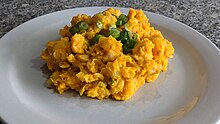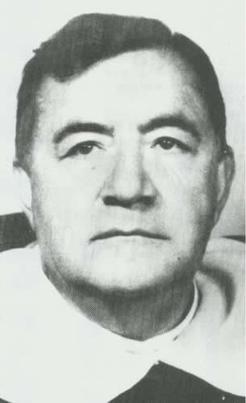
Mote pillo is one of the most typical dishes from Cuenca, the Azuay province and the whole southern highlands in Ecuador. [1]

Mote pillo is one of the most typical dishes from Cuenca, the Azuay province and the whole southern highlands in Ecuador. [1]
According to one of the classic recipes, mote pillo has: corn, eggs, milk, annatto, green onions, and salt. [2] Garlic and cumin are also used. [3]
Mote pillo is one of three emblematic dishes of the Azuay province, the other two being mote sucio (dirty mote, so-called because the corn is combined with crisp pork crumbs), and Motepata, a hearty soup traditionally prepared for carnival.

Ecuador is divided into 24 provinces. The provinces of Ecuador and their capitals are:

Azuay, Province of Azuay is a province of Ecuador, created on 25 June 1824. It encompasses an area of 8,171 square kilometres (3,155 sq mi). Its capital is Cuenca. It is located in the south center of Ecuador in the highlands. Its mountains reach 4,500 m (14,800 ft) above sea level in the national park of El Cajas.

Cuenca, officially Santa Ana de los Ríos de Cuenca, is an Ecuadorian city, head of the canton of the same name and capital of the province of Azuay, as well as its largest and most populated city. It is crossed by the Tomebamba, Tarqui, Yanuncay and Machángara rivers, in the south-central inter-Andean region of Ecuador, in the Paute river basin, at an altitude of 2,538 meters above sea level and with a temperate Andean climate averaging 16.3 °C.

Fanesca is a soup traditionally prepared only on Easter Sunday and is eaten by households and communities in Ecuador. This dish is an Ecuadorian tradition that is prepared to give thanks to God for the food provided and blessings.

Club Deportivo Cuenca is an Ecuadorian football club based in Cuenca. They currently play in the Serie A, the top-flight football league in the country, and is one of two clubs from Cuenca to have played in the top-flight.

Gualaceo Canton, nicknamed “El Jardin del Azuay”, is a canton in the sierra region of Ecuador in the Azuay Province. The seat of the canton Gualaceo, is located 35 km east from the city of Cuenca and is one of the biggest cities in Azuay.

The Real Audiencia of Quito was an administrative unit in the Spanish Empire which had political, military, and religious jurisdiction over territories that today include Ecuador, parts of northern Peru, parts of southern Colombia and parts of northern Brazil. It was created by Royal Decree on 29 August 1563 by Philip II of Spain in the city of Guadalajara. It ended in 1822 with the incorporation of the area into the Republic of Gran Colombia.

Miss Ecuador is a national beauty pageant in Ecuador. The current Miss Ecuador is Delary Stoffers from Guayaquil. She won the title on July 1, 2023, and represented Ecuador at Miss Universe 2023.
The varieties of Ecuadorian maize are the repository of a rich farming and cooking tradition.

Mote is the generic name for several varieties of boiled grains, consumed in many regions of South America. It is usually prepared by boiling the grains in water made alkaline by the addition of ashes or lime, a process known as nixtamalization.
Checa or Jidcay is a town and parish in Cuenca Canton, Azuay Province, Ecuador. The parish covers an area of 64.5 km2 and according to the 2001 Ecuadorian census it had a population total of 2,698.

Llacao is a town and parish in Cuenca Canton, Azuay Province, Ecuador. The parish covers an area of 17.4 km2 and according to the 2001 Ecuadorian census it had a population total of 4501.
Paccha is a town and parish in Cuenca Canton, Azuay Province, Ecuador. The parish covers an area of 25.6 km2 and according to the 2001 Ecuadorian census it had a population total of 5,311.
Ricaurte is a town and parish in Cuenca Canton, Azuay Province, Ecuador. The parish covers an area of 14.3 km² and according to the 2001 Ecuadorian census it had a population total of 14,006.
Sidcay is a town and parish in Cuenca Canton, Azuay Province, Ecuador. The parish covers an area of 17 km2 and according to the 2001 Ecuadorian census it had a population total of 3,439.

Valle is a town and parish in Cuenca Canton, Azuay Province, Ecuador. The parish covers an area of 42.7 km² and according to the 2001 Ecuadorian census it had a population total of 18,692.
Victoria del Portete is a town and parish in Cuenca Canton, Azuay Province, Ecuador. The parish covers an area of 206 km² and according to the 2001 Ecuadorian census it had a population total of 4,617.

Gilberto Almeida Egas was an Ecuadorian painter born in San Antonio de Ibarra, in Imbabura Province. He studied at the School of Fine Arts in Quito from 1953 to 1957. His early work was in many media, especially paintings of buildings and views in old Quito; his later work concentrated on large black-and-white drawings, in a baroque, expressionistic, and dramatic style.

Fray José María Vargas Arévalo O.P. (1902–1988) was an Ecuadorian Dominican friar, writer, and historian.